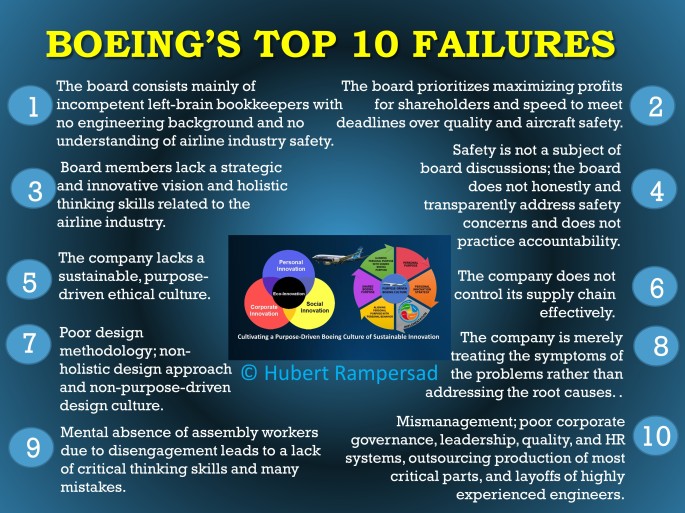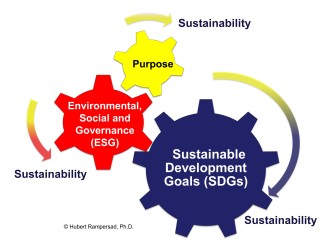Hubert Rampersad, Ph.D.
“The one thing missing from boards of directors is a holistic view on cultivating a purpose-driven culture to fuel sustainable innovation” — Hubert Rampersad
According to Clayton Christensen, a staggering 95% of all product innovations fail. The Startup Genome report also indicates that 92% of startups meet a similar fate. Innovation often fails due to a lack of a sustainable approach to innovations, no holistic approach, and a lack of anchoring innovations in a purpose-driven corporate culture. In today’s complex world, sustainable innovation is crucial. Traditional innovation approaches are inadequate because they lack a holistic approach in which personal innovation, corporate innovation, and social innovation are aligned. The sobering statistics highlight the importance of embedding innovations in a purpose-driven culture in tech companies. The best sustainable innovations align with the innovator’s and company’s purpose and generate mutual value for its stakeholders. When innovations resonate with the employee’s and organization’s higher purpose and benefit the company, its employees, and key constituents, they are more likely to succeed. Purpose-driven tech companies are focused on personal innovation, corporate innovation, and social innovation. They are not only focused on profitability but also on making a positive impact on society. This appears to be different at Boeing, read my article “Boeing’s Top 10 Failures”.
Read: “Boeing lost its way. Other companies should take heed“; it’s become clear that Boeing’s problems run far deeper. They expose decades of American corporate philosophy gone awry. Boeing is a quintessential example of America’s rotting business culture over the past 40 years. Read also “10 Ways to Kill Creativity, Sustainability, and Innovation”.
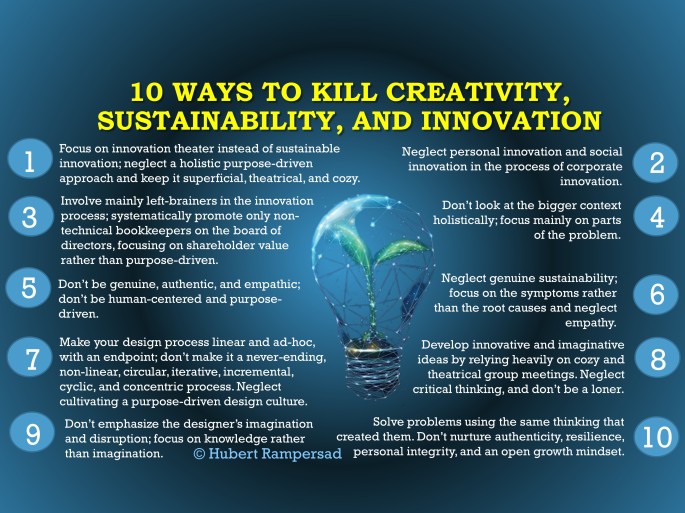
In this article, I propose a holistic framework for building a purpose-driven culture in tech companies that fosters sustainable innovation. The framework includes several key elements, such as fostering authenticity, integrity, and a sense of purpose and empathy among leaders and employees, cultivating sustainable innovation, and integrating sustainability into the company’s business activities. By following this framework, tech companies can create a culture that benefits their bottom line and contributes to the greater good and leaders and employees in these companies will be genuine and true to themselves. It’s based on my experience as a senior design innovation coach at ASML, the most important tech company in the world and Europe’s most valuable tech firm; the only tech company in the world with a design-driven culture.
HOLISTIC MODEL FOR BUILDING A PURPOSE-DRIVEN CULTURE
In this age of sustainability, American tech companies should not only prioritize profits but also promote high values, high character, and critical thinking among their employees. This will help impact our society’s well-being, integrity, and empathy in a positive way. In this article, I provide a holistic model to realize this sustainably, as shown in this diagram. This model is based on my latest book, “Eco-Design Thinking for Personal, Corporate, and Social Innovation.” Read my article “The End of Design Thinking: Cultivating a Purpose-Driven Design Culture to Fix the World”. This model will aid American tech companies to cultivate a purpose-driven culture and create a stable foundation for sustainable innovation.

This holistic, never-ending, purpose-driven cycle entails six stages:
- Developing the personal purpose of leaders and employees entails the foundation for cultivating their authenticity, integrity, empathy, emotional intelligence, critical thinking skills, and character. Personal purpose is associated with ethical and emotionally intelligent individuals with a sense of direction.
- Formulating the personal innovation strategy of leaders and employees; this strategy entails a roadmap to translate their personal purpose into measurable actions.
- Implement and cultivate their personal innovation strategy according to the Plan-Deploy-Act-Challenge cycle to continuously improve and purposely manage themselves to become creative, innovative, and empathic.
- Aligning the personal purpose of leaders and employees with their behavior and actions to cultivate their personal integrity and empathy skills; Remember: “The higher your personal integrity, the better your attentiveness, the better your empathic skills, the more sustainable your innovation”– Hubert Rampersad
- Developing the shared company purpose is about what the company stands for, its reason, and how it benefits society. Shared purpose entails the organization’s soul and joint mission, vision, and core values.
- Aligning the personal purpose with the shared company purpose. This creates uniformity of personal and company values as well as uniformity of personal innovation and corporate innovation. Matching these two purposes and innovations is essential for achieving an ethical, cohesive, unified company and a happy, engaged, committed, and passionate workforce. It’s about aligning the objectives of leaders and employees with those of the company, as well as fostering mutual value addition. It’s about aligning personal innovation with corporate and social innovation.
Below, I will elaborate on each of these six stages.
Personal Purpose
Having a higher purpose in life means you’re living your values and beliefs. Finding your higher purpose is discovering who you are, what you stand for, what matters to you, and what you can contribute to the world. When someone feels that his life lacks purpose, he may struggle to find motivation and direction. This can lead to a sense of detachment from his values and a lack of inspiration to enrich his life and those around him. Finding motivation and direction can be easier when you have a purpose in life. This will inspire you to become more effective, ethical, and fulfilled. Having a purpose in life will inspire you to discover ways to become more creative, imaginative, and innovative. Life is never richer, fuller, or more rewarding than moving faithfully and persistently toward a compelling purpose. Remember what Elon Musk said: “Don’t even attach yourself to a person, a place, a company, an organization, or a project. Attach yourself to a mission, a calling, a purpose only. That’s how you keep power and your peace. It worked pretty well for me this far”.
Your personal purpose entails your identity (mission) and dream (vision). Your dream is related to a higher calling. Everyone has a higher calling, a so-called inner assignment. Personal mission is aimed at being, and personal vision is aimed at becoming. Your personal mission inspires you, and your personal vision motivates you. Your mission and vision statement (personal purpose statement) embodies your values. Your personal mission encompasses your philosophy of life and your overall objectives, indicating who you are, the reason for existence, why you are on earth, what your purpose here is, what you stand for, what values you are most committed to, what is decisive for your success, what is your life purpose, what do you live for, what are your core beliefs, what are your deepest aspirations, what makes you happy, and what do you do that you are most proud of. Your personal mission is your personal leading light, keeping you steadily in the course of your dream. “Who am I?” is an identity question. It initiates self-examination of your personal identity (the unique position you find yourself in) and a voyage of discovery. My mission is: “Enjoy the freedom to unleash the creative potential in others, especially if this can mean something in their life.”
Your personal vision statement is a description of how you want to realize your dream in the long term. It indicates where you are going, which values, beliefs, and principles guide you on your way, why you are involved in the design industry, what you want to achieve, what you desire for your life, what your long-term intentions are, what talents, skills and experiences you need to add value to your others, where you want to be at the end of your life, what you hope to become, where you would like your life to be headed, the ideal characteristics you want to possess, your perfect job situation, and what you desire to be. Ask yourself these questions and answer them honestly. 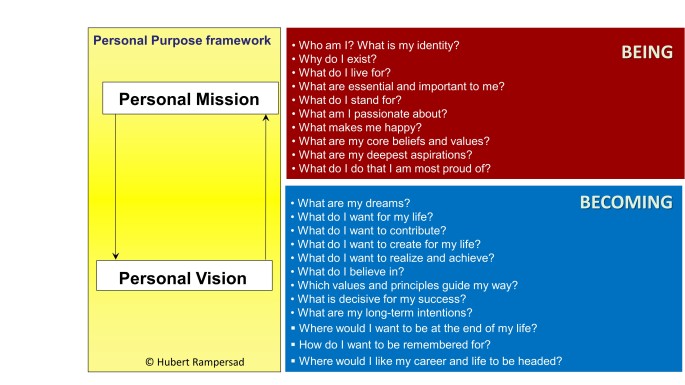
By practicing breathing and silence exercises, you can better connect with your inner self and find answers to these questions. This will help you to discover your higher purpose. Please click on this link to view my personal purpose statement. It also entails my values and beliefs. Read further “How Mindful Meditation Boosts Critical Thinking in the Age of AI and “Crafting Your Authentic Personal Brand: A 5-Step Guide”.
Through this process, you’ll cultivate self-knowledge, self-awareness, self-management, and self-learning, which entails a journey toward personal disruptive innovation, as shown in this diagram:


The best ideas come when you are alone. Self-learning – the ability to gather, process, retain, and evaluate knowledge alone — is the foundation of creativity and imagination. Traditional creativity approaches lack imagination because they neglect self-learning and, because of this, fail to address complex problems. They heavily rely on group meetings and, therefore, miss opportunities to develop innovative and imaginative ideas. Nikola Tesla developed many innovative ideas while working alone for over thirty years. Similarly, Stephen Hawking made significant discoveries while confined to his wheelchair, and Isaac Newton famously discovered gravity while in social isolation. Remember Nikola Tesla’s statement: “Being alone is when ideas are born. This is the secret of innovation”. Albert Einstein said almost the same: “Albert Einstein said almost the same: “Be a loner. That gives you time to wonder, to search for the truth. Have holy curiosity. Make your life worth living”.
Personal Innovation Strategy
To bring your purpose alive, you must translate it into measurable actions. Leaders and employees should formulate their personal innovation strategy to get their personal purpose to life. This is a roadmap to developing a growth mindset, authenticity, integrity, empathy, and critical thinking skills. Without continuous improvement based on your personal innovation strategy, you won’t be successful in life and business. The following are the five steps to develop your personal innovation strategy: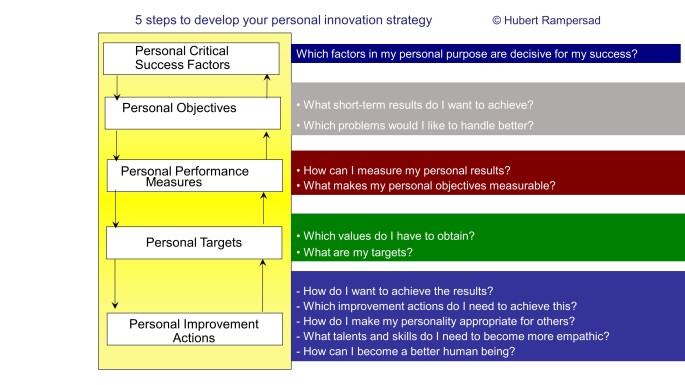
Your personal innovation strategy helps you turn your personal purpose into manageable, measurable objectives and milestones in a balanced way. Using this strategy, you can effectively manage your time and become more disciplined, proactive, innovative, and empathetic. Please click on this link to view my personal innovation strategy. Suppose you want to learn more about this personal innovation strategy system. In that case, I recommend reading my articles “How to Redesign Your Life Based on Your Personal Innovation Strategy” and “Cultivating Critical Thinking in the Age of AI.”
Implementation According to the PDAC Cycle
Once you have established your personal innovation strategy, it is essential to consistently implement, maintain, and cultivate it to effectively manage and challenge yourself in your personal and company life. To aid you in this process, I recommend following the PDAC cycle (Plan-Deploy-Act-Challenge), which is a continuous improvement cycle that will help implement your personal innovation strategy effectively, as illustrated in this diagram:

Implementing your personal innovation strategy through the PDAC cycle will lead to self-awareness, happiness, personal disruption, and enhanced authenticity, integrity, empathy, and critical thinking skills. It’s important to regularly update your personal innovation strategy and repeat the cycle to stay current with new challenges and lessons learned. These 50 tips will assist you in implementing your personal innovation strategy effectively.
Aligning Personal Purpose with Personal Behavior
The next stage ensures harmony between your purpose and actions, aligning your deeds with your conscience. Our conscience is the inner voice that guides us to distinguish between right and wrong, fact and fiction. By listening to this voice, we can gain better insight into our empathic behavior, strengths, and weaknesses, ultimately impacting our solidarity with others. Albert Schweitzer once said: “The first step in the evolution of ethics is a sense of solidarity and empathy with other human beings.” This diagram illustrates this personal integrity concept.

“Empathy is the key to innovate sustainably. Personal integrity is the foundation of empathy. The higher one’s personal integrity, the more empathetic he becomes. This leads to sustainable innovations”– Hubert Rampersad.
To enhance empathy and personal integrity, aligning your personal purpose with your behavior is essential. This involves achieving more excellent compatibility between the two elements so that they are in harmony, as shown in the above diagram. When your personal purpose and behavior match, you can work authentically and purposefully without internal conflicts. This will lead to greater empathy, enhanced charisma, transparency, and trustworthiness.
Personal integrity and empathy
I advise leaders and employees to balance their personal purpose with their current behavior and actions to develop personal integrity and empathy. During this alignment process, they must reflect honestly on the following questions: What are my personal values, and how do they align with my actions? How can I ensure that my actions are consistent with my values? What are the potential consequences of my efforts toward others? How can I empathize with others and understand their perspectives? Am I staying true to my values and conscience in my actions? Are my thoughts and actions aligned consistently? How do my values and intentions relate to my current behavior? Is there congruity between my thoughts and my actions? Am I always acting according to my personal ambition and empathetic nature? Does my personal purpose reflect my desire to work with ethics and empathy? Are there any discrepancies between my personal purpose and my compassionate actions? Do I keep the promises I make to myself? How do others perceive me and my values? Do they see me as someone who stays true to my core beliefs and remains authentic to myself? They must also ask themselves: Have I always acted by my conscience? Have I always done what was right? Have I always worked morally? Have I performed compassionately regularly?
Shared Company Purpose
The shared company purpose statement differs from a personal one, but the fundamental principles remain the same. The shared company purpose entails the company mission, vision, and core values to inspire leaders and employees toward a common goal. The mission encompasses the company’s identity, while the vision is its long-term dream, based on several core values used to strengthen the single-mindedness of its people. The related questions are included in this below diagram: 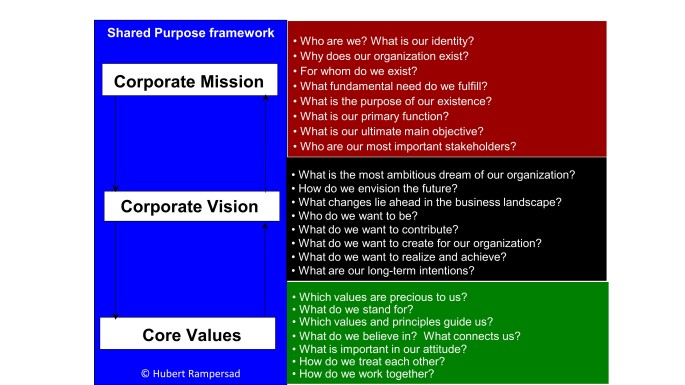
Look at SpaceX’s and Tesla Inc.’s shared purpose statement.

Aligning Personal Purpose with Shared Company Purpose
Aligning personal purpose with shared company purpose creates uniformity of personal and organizational values. Matching these two purposes involves reaching a higher compatibility between personal and company objectives and mutual value addition. To foster better ethics in the organization and become a purpose-driven company, I encourage leaders and employees to formulate their personal purpose and reflect on aligning their personal purpose with the shared company purpose, as shown in this Figure. This will help them to find their higher purpose and cultivate a good character.

Leaders must communicate their personal purpose to their employees and coach them in this alignment process. By unifying the shared company purpose with their personal purpose, you will create a strong foundation of peace, integrity, engagement, and learning upon which creativity, productivity, and growth can flourish, and life within the company will become a more harmonious and ethical culture. This will catalyze innovation by encouraging a learning culture of curiosity and exploration in the organization. This process is about getting the optimal fit and balance between these activities to enhance productivity, create a climate of trust, and cultivate a purpose-driven tech company. This process is needed because leaders and employees don’t work, study passionately, or expend energy on something they do not believe in or agree with. If there is an effective match between their interests and those of the company, and if their values and the institution’s values align, they will be actively engaged and motivated. This will create trust, and they will work with outstanding commitment and dedication toward realizing the company’s objectives. When their personal purpose is in harmony with the shared purpose (are compatible) and combined in the best interest of both parties, the results will be the good character of leaders and employees, restoration of their higher purpose, trust, engagement, collective sense of belonging, and cultivation of innovation and sustainability. In this way, they are stimulated to commit, act ethically, and focus on those activities that create value for the company, themselves, and others.
Purpose Meeting
I recommend introducing a purpose meeting between leaders and their employees to build a sustainable higher-purpose culture. This meeting is a periodical, informal, voluntary, trusted, and confidential meeting of half an hour between the parties, aligning the personal purpose with the shared purpose as a topic. The purpose meeting also includes individual coaching. It is recommended to be held structurally at least once every two months. The leader plays a crucial role in this process. He/she should be an empathetic, trusted leader, coach, mentor, and role model. This approach fosters ethical awareness among leaders and employees, creating a purpose-driven company. When they see their efforts as part of a greater purpose, they will be more likely to invest their creativity, passion, and energy into their work and work smarter.
A study by Towers Perrin found that instead of matching the right employee to the correct position for long-term success, most US companies and human resource departments emphasize simply filling the job as quickly as possible and on corrupt DEI policies, read “Why DEI Sucks; How to Measure and Fix DEI“. As a result, American companies are losing money as fast as they lose employees. Getting the optimal fit between personal and shared purpose has become necessary to enhance workforce productivity and stimulate creativity, learning, engagement, commitment, and passion.
SUSTAINABLE INNOVATION
In today’s complex world, sustainable innovation is crucial. Traditional innovation approaches are inadequate because they lack a holistic approach. Instead, they are superficial, theatrical, and cozy. Technology companies should prioritize sustainable innovation as a fundamental capability to achieve sustainable growth and competitive advantage. Unfortunately, there are no real good examples of American tech companies focused on sustainable innovation. Apple, Google, IBM, Samsung, Uber, Airbnb, Lockheed Martin, Northrop Grumman, Boeing, OceanGate, Tesla, and SpaceX are not design-driven due to their poor design approach they learned at Stanford, MIT, and Harvard. Read my article “Cultivating a Sustainable Purose-Driven Design Culture in Tech Companies”.

We must develop and implement innovative ideas better, faster, smarter, and sustainably. This is why I introduced the Eco-Innovation concept. Eco-Innovation involves integrating sustainability into the process of innovation. I identify three types of innovation that fall under this category:

- Personal innovation is unlocking your creative potential and creating new opportunities for yourself. By disrupting your current market, you can make a significant social impact. Personal Disruptive Innovation by Hubert Rampersad helps you find your higher purpose and improve your business and personal life for greater happiness and success. Combining personal disruptive innovation with corporate innovation and social innovation will help you generate more imaginative, innovative, empathetic, and disruptive ideas. “We need to understand that all knowledge starts with self-knowledge, all learning starts with self-learning, all innovation starts with self-innovation (personal innovation), real empathy starts with personal integrity, and without empathy, innovations are not sustainable ”- Hubert Rampersad
- Corporate innovation involves applying new ideas to create new products, processes, or services that increase the value of a company. Corporate innovation also encompasses Open Innovation by Chesbrough, Disruptive Innovation by Clayton Christensen, and BlockChain Innovation.
- Social innovation is developing and implementing new ideas and solutions that meet social needs and strengthen civil society. There is some overlap between social innovation and social entrepreneurship. Social innovation aims to improve the world by implementing innovative ideas that create social and environmental change, benefiting many people. Social entrepreneurs seek the most effective ways to achieve their social mission and provide social benefits.
The diagram below shows how personal, corporate, and social innovation are interconnected. Personal innovation is linked to self-learning, corporate innovation is linked to organizational learning, and social innovation is linked to community learning.
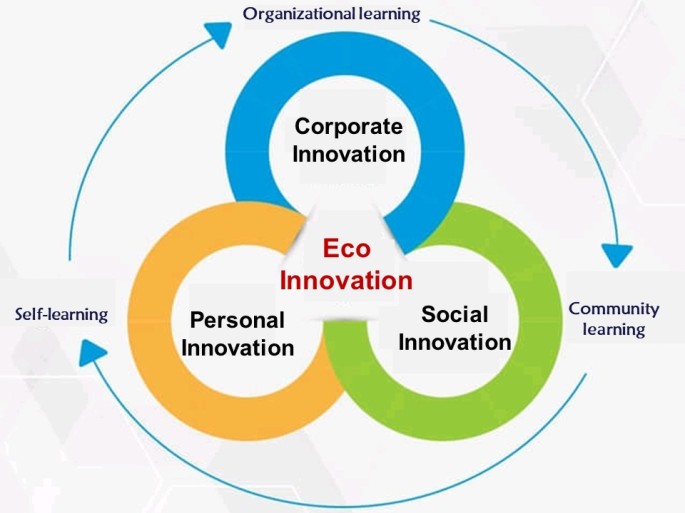
Traditional innovation approaches are unsuitable for a sustainable circular economy as they focus on process-driven, analytical thinking, cozy, theatrical meetings, and completing related tasks in a particular order using design tools. These approaches lack imagination and fail to address the larger picture. We must adopt a new design method better suited for sustainable innovation. I have therefore introduced eco-design thinking. This creative process involves empathizing with yourself, the end user, and the environment to generate innovative, imaginative, empathetic, and disruptive design ideas that are better aligned with social innovation. The new model is depicted in the figure below and consists of four stages: Explore, Ideate, Prototype, and Execute. It is an iterative, incremental, cyclic, and concentric process of exploring, ideating, prototyping, and executing (Rampersad, 2023).

Eco-design thinking is a circular and iterative process that has no endpoint. The model consists of various stages that may form iterative loops and do not need to follow a specific sequence. Every iteration brings forth fresh insights. Eco-design thinking is a continuous and circular process that requires testing and refining your design while empathizing with yourself, the users, and the environment. Read also “How SDGs, ESG, and Purpose Fuel Design For Sustainability”.
The most important benefits of this new design model are: Before delving into corporate innovation issues, exploring and redesigning your own life to become innovative is essential, which leads to more empathetic, intelligent, and sustainable innovations that are in line with social innovation and the higher purpose of the company and its employees; A high level of personal integrity and a designer’s empathy is necessary to achieve superior design quality; By gradually building and enhancing the product and detecting defects early on, you can achieve better and more sustainable innovation outcomes.
Hubert Rampersad, Ph.D.
Complimentary Initial Consultation to Enhance Your Design Process and Boost Design Team Performance
If you’re interested in gaining more knowledge about this program, you may want to consider joining our Orlando–Tampa Live Events:
Cultivating a Purpose-Driven Boeing Culture
Cultivating a Purpose-Driven and Design Culture in Tech Companies

How Sustainability and Generative AI Fuel Design Innovation
Cultivating Authenticity, Integrity, Empathy, and Critical Thinking in the Age of AI
Purpose-Driven and Human-Centered AI
Hubert Rampersad, Ph.D., is a Dutch-American innovation expert who founded the Center of Excellence in Human-Centered and Purpose-Driven Innovation in Orlando. He is a visionary leader in innovative solutions for genuine sustainability, disruptive design innovation, critical thinking in the age of AI, human-centered and purpose-driven AI, and entrepreneurial leadership. He holds a Ph.D. in Innovation Sciences, an MSc in Technology Engineering & Robotics, and a BSc in Mechanical Engineering from leading accredited universities in the Netherlands (Delft University of Technology, Eindhoven University of Technology). He is a well-known futurist, advocating for genuine sustainability on a global scale. With extensive knowledge and expertise, he has authored 25 books on the topics above in many languages and is highly regarded for his insights in these fields. One of his books, “Total Performance Scorecard,” has been published in 20 languages. Dorothy Leonard, an innovation professor at Harvard Business School, wrote the book’s foreword. Rampersad has also previously served as a guest lecturer at MIT Sloan and was featured in BusinessWeek. He was a senior design innovation coach at ASML, the most important tech company in the world and “Europe’s most valuable tech firm“.

Orlando, Florida | tpsi@live.com | Phone/WhatsApp: +13053992116


